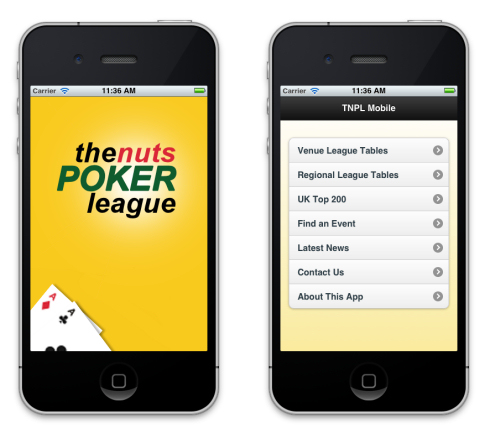TNPL Mobile
The Official Nuts Poker League Mobile App
As the official Nuts Poker League Mobile Application TNPL Mobile enables you to check venue, regional and national league tables, view individual event turnout and winners, find your nearest venues and keep up-to-date with the latest news from the league on the go.
Designing, developing, deploying, and promoting native iOS and Android apps requires a well-planned and organised approach to ensure the best possible outcome. Here is a step-by-step guide to best practice procedure for creating native mobile apps:
- Define the scope of the project: The first step in the process is to define the scope of the project, including the features and functionality that you want to include in the app. This should be based on your business goals and the needs of your target audience. It is important to be realistic about what you can achieve within your budget and timeline, and to prioritise the most important features.
- Conduct market research: Once you have defined the scope of the project, it is a good idea to conduct market research to gather insights about your target audience and competitors. This can help you to identify opportunities and challenges, and to refine your concept for the app.
- Design the user experience: The user experience (UX) of your app is crucial to its success, so it is important to give careful consideration to the design of the app. This includes things such as the layout, navigation, and overall look and feel of the app. It is a good idea to create wireframes and prototypes to test and refine the UX before moving on to the development phase.
- Develop the app: Once the design is complete, it is time to start the development phase. This involves writing the code for the app, integrating any necessary APIs and services, and testing the app to ensure that it is functional and meets the requirements of the project.
- Deploy the app: Once the app is developed, it is time to deploy it to the app stores. This involves preparing the app for submission, including creating screenshots and other marketing materials, and submitting the app to the relevant app store (Apple App Store for iOS apps, and Google Play Store for Android apps).
- Promote the app: After the app is live in the app stores, it is important to promote it to reach a wider audience. This may involve things such as social media marketing, paid advertising, and public relations efforts. It is also a good idea to gather feedback from users and incorporate it into updates and improvements to the app.
In conclusion, designing, developing, deploying, and promoting native mobile apps requires a well-planned and organised approach. This includes defining the scope of the project, conducting market research, designing the user experience, developing the app, deploying it to the app stores, and promoting it to reach a wider audience. By following these best practices, you can create a successful native mobile app that meets the needs of your target audience and helps to achieve your business goals.
One additional tip to consider is to regularly update and maintain the app after its initial launch. This includes fixing any bugs or issues that arise, as well as adding new features and functionality to keep the app fresh and engaging for users. Regular updates and maintenance can help to improve user retention and increase the overall success of the app.
It is also important to consider the importance of security when designing, developing, and deploying a mobile app. This includes things such as protecting user data, securing the app's backend infrastructure, and following best practices for secure coding. Failing to prioritise security can lead to vulnerabilities and data breaches, which can have serious consequences for your business and your users.
Finally, it is a good idea to seek the assistance of professionals throughout the process of designing, developing, and deploying a mobile app. This may include things such as hiring a designer to create the UX, hiring a developer to write the code, and hiring a marketing agency to promote the app. Working with professionals can help to ensure that the app is of high quality and meets the needs of your business and target audience.
In summary, creating a successful native mobile app requires careful planning and execution. It is important to define the scope of the project, conduct market research, design a user-friendly experience, develop the app with a focus on security, and deploy and promote the app effectively. By following these best practices and seeking the assistance of professionals as needed, you can create a successful native mobile app that meets the needs of your business and target audience. Regular updates and maintenance can help to keep the app fresh and engaging for users, and can contribute to the overall success of the app. By prioritising the user experience and security, and by following best practices throughout the development process, you can create a native mobile app that stands out in the crowded app market and helps your business to achieve its goals.









